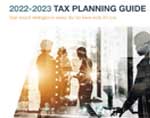Some people mistakenly believe that Social Security benefits are always free from federal income tax. Unfortunately, that’s often not the case. In fact, depending on how much overall income you have, up to 85% of your benefits could be hit with federal income tax.
While the truth about the federal income tax bite on Social Security benefits may be painful, it’s better to understand it. Here are the rules.
Calculate provisional income
The amount of Social Security benefits that must be reported as taxable income on your tax return depends on your “provisional income.” To arrive at provisional income, start with your adjusted gross income (AGI), which is the number that appears on Page 1, Line 11 of Form 1040. Then, subtract your Social Security benefits to arrive at your adjusted AGI for this purpose.
Next, take that adjusted AGI number and add the following:
- 50% of Social Security benefits,
- Any tax-free municipal bond interest income,
- Any tax-free interest on U.S. Savings Bonds used to pay college expenses,
- Any tax-free adoption assistance payments from your employer,
- Any deduction for student loan interest, and
- Any tax-free foreign earned income and housing allowances, and certain tax-free income from Puerto Rico or U.S. possessions.
The result is your provisional income.
Find your tax scenario
Once you know your provisional income, you can determine which of the following three scenarios you fall under.
Scenario 1: All benefits are tax-free
If your provisional income is $32,000 or less, and you file a joint return with your spouse, your Social Security benefits will be federal-income-tax-free. But you might owe state income tax.
If your provisional income is $25,000 or less, and you don’t file jointly, the general rule is that Social Security benefits are totally federal-income-tax-free. However, if you’re married and file separately from your spouse who lived with you at any time during the year, you must report up to 85% of your Social Security benefits as income unless your provisional income is zero or a negative number, which is unlikely.
Having federal-income-tax-free benefits is nice, but, as you can see, this favorable outcome is only allowed when provisional income is quite low.
Scenario 2: Up to 50% of your benefits are taxed
If your provisional income is between $32,001 and $44,000, and you file jointly with your spouse, up to 50% of your Social Security benefits must be reported as income on Form 1040.
If your provisional income is between $25,001 and $34,000, and you don’t file a joint return, up to 50% of your benefits must be reported as income.
Scenario 3: Up to 85% of your benefits are taxed
If your provisional income is above $44,000, and you file jointly with your spouse, you must report up to 85% of your Social Security benefits as income on Form 1040.
If your provisional income is above $34,000, and you don’t file a joint return, the general rule is that you must report up to 85% of your Social Security benefits as income.
As mentioned earlier, you also must report up to 85% of your benefits if you’re married and file separately from your spouse who lived with you at any time during the year — unless your provisional income is zero or a negative number.
Turn to us
This is only a very simplified explanation of how Social Security benefits are taxed. With the necessary information, we can precisely calculate the federal income tax, if any, on your Social Security benefits.
© 2024




